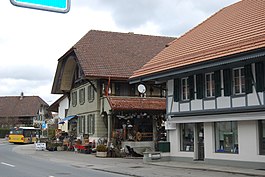Hindelbank
| Hindelbank | ||
|---|---|---|

Hindelbank
|
||
|
||
| Coordinates: 47°3′N 7°32′E / 47.050°N 7.533°ECoordinates: 47°3′N 7°32′E / 47.050°N 7.533°E | ||
| Country | Switzerland | |
| Canton | Bern | |
| District | Emmental | |
| Area | ||
| • Total | 6.73 km2 (2.60 sq mi) | |
| Elevation | 519 m (1,703 ft) | |
| Population (Dec 2015) | ||
| • Total | 2,414 | |
| • Density | 360/km2 (930/sq mi) | |
| Postal code | 3324 | |
| SFOS number | 0409 | |
| Surrounded by | Bäriswil, Kernenried, Krauchthal, Lyssach, Mattstetten, Mötschwil, Münchrigen | |
| Website |
www SFSO statistics |
|
Hindelbank is a municipality in the administrative district of Emmental in the canton of Bern in Switzerland.
Hindelbank is first mentioned in 1275 as Hundelwanc.
The earliest human traces are some possibly neolithic items have been discovered in the village. The remains of a Roman era settlement were discovered at Lindachfeld. The village formed the center of a small lower court. Beginning in 1347 the village and its court passed through the hands of a number of local nobles as it was sold, divided and inherited repeatedly. In 1406 the village was acquired by Bern and the court continued to pass through the hands of Bernese nobles. After the 1798 French invasion, under the Helvetic Republic the local court was dissolved. Five years later, under the Act of Mediation, it became part of the district of Burgdorf.
The village church was first mentioned in 1275. The old church was replaced with a new building in 1514-18. The church tower was built almost a century and a half later in 1666-68. After a fire in 1911, the building was repaired and renovated. Two monumental tombs were carved in the church by Johann August Nahl.
The village converted to mechanized farming relatively early. In 1878 the regional Dampfdresch-Genossenschaft or steam farming cooperative was established in the village. The dairy and potato distillery in the village led to the creation, in 1888, of a yeast factory. Several other factories opened as well, including a biscuit factory in 1920, a gravel mine in 1960 and a laundry. In 1960's a freight yard opened which took advantage of the nearby A1 motorway. Good transportation links, including the motorway and the railroad, have allowed the village's population to grow rapidly. While several factories were built in the early 20th century, in the later half century the population grew while industry remained constant. Today many residents commute to jobs in neighboring towns.
...
Wikipedia




